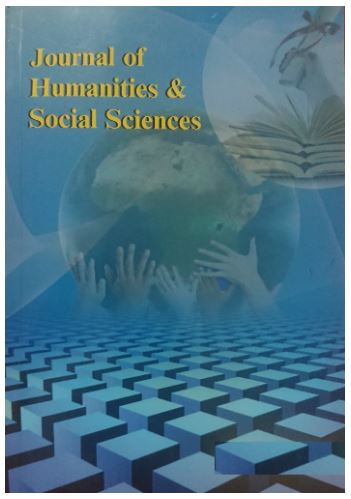A Lexical Analysis of the Verb of Perception BONA (see) in Setswana
Corresponding Author(s) : Andy Chebanne
Journal of Humanities & Social Science (JHSS),
Vol. 11 No. 1 (2022)
Abstract
The verb ‘BONA’ (to see) in Setswana represents semantic entailments that are not included
in the general entailments that the verb of most perceptions UTLWA (perceive – taste,
hear, comprehend, smell, feel) presents. The critical question is what is the basis of the
exclusion of BONA from the semantic entailments found in UTLWA? To respond to this
question, it is important to examine and characterize the semantic domains of BONA. This
verb demonstrates some interesting polysemism when used in different syntactic
contexts. The paper will first present the verbs of perceptions in Setswana and their
semantic relationships. Further, it will suggest that in the lemmatization of BONA, its
varied and specialized semantic entailments that characterize it need to be presented and
discussed critically to capture the cultural and linguistic richness of this verb.
Keywords
Download Citation
Endnote/Zotero/Mendeley (RIS)BibTeX
- Allan, K. 2001. Natural Language Semantics. Oxford: Blackwell Publishers.
- Arnoff, M. & J. Rees-Miller (Eds.). 2001. An Introduction to Formal Semantics. Oxford: Blackwell
- Publishers.
- Bresnan, J. & J. Kanerva. 1992. Locative Inversion in Chichewa: A Case Study of Factorization of
- Grammar. In T. Stowell & E. Wehrli Eds. Syntax and the Lexicon. Syntax and Semantics, 26: 53–101.
- New York: Academic Press. Also in Linguistic Inquiry 20.1.1988.
- Chebanne, A. 2009. Semantic Domains and Polysemy of Two Setswana Verbs, Dira and UTLWA: How
- a Monolingual Setswana Dictionary Should Lematize Them? In: Thapelo Otlogetswe (ed.): MLA
- Kgasa–a Pioneer Setswana Lexicographer. CASAS Book Series, 64: 175–190.
- Chebanne, A & J. Creissels. 1990. Etude Lexicale et Semantique des Verbes du Tswana BONA, DIRA
- et UTLWA. Manuscript. Universite Stendhall, UER de Sciecnes du Langage.Grenoble.
- Cole, D. & L. Moncho-Warren. 2012. Macmillan Setswana and English Illustrated Dictionary. Macmillan:
- Northlands.
- Frajzyngier, Z. 1997. Bidirectionality of Grammaticalization. In: African Languages at the Cross
- Roads. In, Papers from Kwaluseni, Edited by Robert K. Herbert. Rüdiger Köppe Verlag Köln.
- Germany.
- Harris, D. W. 2017. The History and Prehistory of Natural Language Semantics. In S. Lapointe and
- C. Pincock (eds.), Innovations in the History of Analytical Philosophy. Palgrave Innovations in
- Philosophy, Doi 10.1057/978–1–137–40808–2_6
- Howard Hughes Medical Institute. 1995. Seeing, Hearing, and Smelling the World. New Findings Help
- Scientist Make Sense of Our Senses. Maryland: Howard Hughes Medical Institute.
- Liu, M., H. Chu-Ren & L. Jia-Ying. 1999. Semantic Representation of Verbal Information - A case from
- Mandarin Verbs of Judging. Presented at ROCLING XII. August 26–27. Hsinchu: National Jiaotung
- University
- Mchombo, S. A. 1999a. Argument Structure and Verbal Morphology in Chichewa. Malawian Journal
- of Linguistics, 1: 57–75.
- Morapedi, S.. 2001. Argument Structure Alternations in Setswana. Thesis, Masters in Linguistics,
- University of Essex, UK.
- Morapedi, S. 2009. Verbal Extensions and Alternations in Setswana. In: Thapelo Otlogetswe (ed.):
- MLA Kgasa–a Pioneer Setswana Lexicographer. CASAS Book Series, 64: 76–92.
- Otlogetswe, T. 2012. Tlhalosi ya Medi ya Setswana (The Medi Setswana dictionary). Medi Publishing.
- Gaborone.
- Otlogetswe, T.J. 2007a. English-Setswana Dictionary. Pentagon Publishers. Gaborone.
- Otlogetswe, T.J. 2007b. Corpus Design for Setswana Lexicography, PhD thesis. University of Pretoria.
- Snyman, J.W., J.S. Shole & J.C. Le Roux. 1990. Dikišinare ya Setswana English Afrikaans. Pretoria: Via
- Afrika Limited.
- Viberg Å. 1983. The Verbs of Perception: A Typological Study. Linguistics, 21: 123–162
References
Allan, K. 2001. Natural Language Semantics. Oxford: Blackwell Publishers.
Arnoff, M. & J. Rees-Miller (Eds.). 2001. An Introduction to Formal Semantics. Oxford: Blackwell
Publishers.
Bresnan, J. & J. Kanerva. 1992. Locative Inversion in Chichewa: A Case Study of Factorization of
Grammar. In T. Stowell & E. Wehrli Eds. Syntax and the Lexicon. Syntax and Semantics, 26: 53–101.
New York: Academic Press. Also in Linguistic Inquiry 20.1.1988.
Chebanne, A. 2009. Semantic Domains and Polysemy of Two Setswana Verbs, Dira and UTLWA: How
a Monolingual Setswana Dictionary Should Lematize Them? In: Thapelo Otlogetswe (ed.): MLA
Kgasa–a Pioneer Setswana Lexicographer. CASAS Book Series, 64: 175–190.
Chebanne, A & J. Creissels. 1990. Etude Lexicale et Semantique des Verbes du Tswana BONA, DIRA
et UTLWA. Manuscript. Universite Stendhall, UER de Sciecnes du Langage.Grenoble.
Cole, D. & L. Moncho-Warren. 2012. Macmillan Setswana and English Illustrated Dictionary. Macmillan:
Northlands.
Frajzyngier, Z. 1997. Bidirectionality of Grammaticalization. In: African Languages at the Cross
Roads. In, Papers from Kwaluseni, Edited by Robert K. Herbert. Rüdiger Köppe Verlag Köln.
Germany.
Harris, D. W. 2017. The History and Prehistory of Natural Language Semantics. In S. Lapointe and
C. Pincock (eds.), Innovations in the History of Analytical Philosophy. Palgrave Innovations in
Philosophy, Doi 10.1057/978–1–137–40808–2_6
Howard Hughes Medical Institute. 1995. Seeing, Hearing, and Smelling the World. New Findings Help
Scientist Make Sense of Our Senses. Maryland: Howard Hughes Medical Institute.
Liu, M., H. Chu-Ren & L. Jia-Ying. 1999. Semantic Representation of Verbal Information - A case from
Mandarin Verbs of Judging. Presented at ROCLING XII. August 26–27. Hsinchu: National Jiaotung
University
Mchombo, S. A. 1999a. Argument Structure and Verbal Morphology in Chichewa. Malawian Journal
of Linguistics, 1: 57–75.
Morapedi, S.. 2001. Argument Structure Alternations in Setswana. Thesis, Masters in Linguistics,
University of Essex, UK.
Morapedi, S. 2009. Verbal Extensions and Alternations in Setswana. In: Thapelo Otlogetswe (ed.):
MLA Kgasa–a Pioneer Setswana Lexicographer. CASAS Book Series, 64: 76–92.
Otlogetswe, T. 2012. Tlhalosi ya Medi ya Setswana (The Medi Setswana dictionary). Medi Publishing.
Gaborone.
Otlogetswe, T.J. 2007a. English-Setswana Dictionary. Pentagon Publishers. Gaborone.
Otlogetswe, T.J. 2007b. Corpus Design for Setswana Lexicography, PhD thesis. University of Pretoria.
Snyman, J.W., J.S. Shole & J.C. Le Roux. 1990. Dikišinare ya Setswana English Afrikaans. Pretoria: Via
Afrika Limited.
Viberg Å. 1983. The Verbs of Perception: A Typological Study. Linguistics, 21: 123–162
